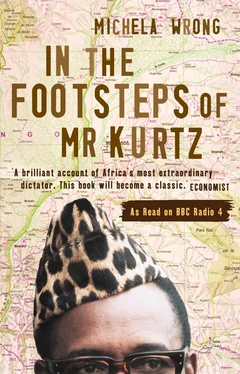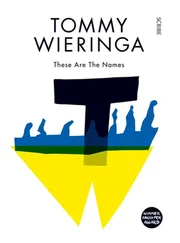Drawing up outside the Hotel Intercontinental, effectively barring all exits, were several military armoured cars, crammed with members of the Special Presidential Division (DSP), the dreaded elite unit dedicated to President Mobutu’s personal protection and held responsible for the infamous Lubumbashi massacre. A black jeep with tinted windows had careered up to the side entrance and its owner – Mobutu’s own son Kongulu, a DSP captain – was now levelling his sub-machine gun at the night receptionist.
Kongulu, who was later to die of AIDS, was a stocky, bearded man with a taste for fast cars, gambling and women. He left unpaid bills wherever he went with creditors too frightened to demand payment of the man who had been nicknamed ‘Saddam Hussein’ by Kinshasa’s inhabitants. Now he was in full combat gear, bristling with grenades, two gleaming cartridge belts crisscrossed Rambo-style across his chest. And he was very, very angry.
Screaming at the receptionist, he demanded the room numbers of an army captain and another high-ranking official staying at the Intercontinental, men he accused of betraying his father, who had fled with his family hours before rather than face humiliation at the hands of the rebel forces advancing on the capital.
Up in Camp Tsha Tshi, the barracks on the hill which housed Mobutu’s deserted villa, Kongulu’s fellow soldiers had already killed the only man diplomats believed was capable of negotiating a peaceful handover. With the rebels believed to be only a couple of hours’ march away, Kongulu and his men were driving from one suspected hideout to another in a mood of grim fury, searching for traitors. Their days in the sun were over, they knew, but they would not go quietly. They could feel the power slipping through their fingers, but there was still time, in the moments before Mobutu’s aura of invincibility finally evaporated in the warm river air, for some score-settling.
The hotel incident swiftly descended into farce, as things had a tendency to do in Zaire.
‘Block the lifts,’ ordered the hotel’s suave Jordanian manager, determined, with a level of bravery verging on the foolhardy, to protect his guests. The night staff obediently flipped the power switch. But by the time the manager’s order had got through, Kongulu and two burly soldiers were already on the sixteenth floor.
Storming from one identical door to another, unable to locate their intended victims – long since fled – and unable to descend, the death squad was reaching near-hysteria. ‘Unblock the lifts, let them out, let them out,’ ordered the manager, beginning to feel rattled. Incandescent with fury, the trio spilled out into the lobby. Cursing and spitting, they mustered their forces, revved their vehicles and roared off into the night, determined to slake their blood lust before dawn.
The waiting was at an end. May 17, 1997 was destined to be showdown time for Zaire. And it looked uncomfortably clear that the months of diplomatic attempts to negotiate a deal that would ease Mobutu out and rebel leader Laurent Kabila in, preventing Kinshasa from descending into a frenzy of destruction behind the departing president, had come to precisely nothing.
The fact that so many of the key episodes in what was to be Zaire’s great unravelling took place in the Hotel Intercontinental was not coincidental. Africa is a continent that seems to specialise in symbolic hotels which, for months or years, are microcosms of their countries’ tumultuous histories. They are buildings where atrocities are committed, coups d’état consecrated, embryonic rebel governments lodged, peace deals signed, and when the troubled days are over, they still miraculously come up with almond croissants, fresh coffee and CNN in most rooms.
In Rwanda, that role is fulfilled by the Mille Collines hotel, where the management stared down the Hutu militiamen bent on slaughtering terrified Tutsi guests during the 1994 genocide. In Zimbabwe, it used to be the Meikles, where armed white farmers rubbed shoulders with sanction-busters during the Smith regime. In Ethiopia it is the Hilton, where during the Mengistu years some staff doubled as government informers; in Uganda, the Nile, whose rooms once rang with the screams of suspects being tortured by Idi Amin’s police.
In Congo the honour most definitely goes to the Hotel Intercontinental. I know, because I once lived there. With one room as my living quarters, another as dilapidated office and a rooftop beer crate as the perch for a satellite telex – my link with the outside world – I soon realised that the hotel, as emblematic of the regime as Mobutu’s leopardskin hat, offered the perfect vantage point from which to observe the dying days of the dinosaur.
The hotel was built on a whim. On a visit to Abidjan in the Ivory Coast, President Mobutu saw the Hotel Ivoire, and decided he wanted one too. For once, his impulses were based on canny business instincts. The Intercontinental was the first five-star hotel in Kinshasa. Until the restoration of the Hotel Memling, its rival in the town centre, there was simply nowhere else to go for VIPS seeking the bland efficiency only an international hotel chain can deliver. During the prosperous 1970s, the 50 per cent government stake in the building was a share in a certified cash cow.
Constructed on a spur of land in leafy Gombe, a district of ambassadors’ residences and ministries, it enjoys some of the best views in Kinshasa. To the east, the Congo river traces a lazy sweep as it emerges from Malebo pool, an expanse of water so vast that, venturing out in a small boat, you can lose sight of the opposite banks and end up wondering whether, by some miracle of geography, you have drifted out to sea.
Across the water, which is transformed into a disturbed mirror of silver and gold each sunset, gleams the distinctive concave tower that serves as the city of Brazzaville’s landmark. The river, that concourse Marlow described as ‘an immense snake uncoiled, with its head in the sea, its body at rest curving afar over a vast country, and its tail lost in the depths of the land’ is the frontier, a fact exploited by the fishermen whose delicate pirogues languidly traverse the waterway for a spot of incidental smuggling.
Nowhere else in the world do two capitals lie so close to each other, within easy shelling distance, in fact, a feature that has been of more than merely abstract interest in the past. The proximity allows each city to act as an impromptu refugee camp when things get too hot at home. From Brazzaville to Kinshasa, from Kinshasa to Brazzaville, residents ping-pong irrepressibly from one to another – sinks, toilets and mattresses on their heads, depending on which capital is judged more dangerous at any given moment.
In peacetime, the river offers release to Kinshasa’s claustrophobic expatriates. Roaring upstream in their motorboats, they picnic in the shimmering heat given off by the latest sandbank deposited by the current or scud across the waves on waterskis, weaving around the drifting islands of water hyacinth. Legend has it a European ambassador was once eaten by a crocodile while swimming and freshwater snakes are said to thrive. Yet far more ominous, for swimmers, is the steady pull of the river, the relentless tug of a vast mass of water powering relentlessly to the sea.
Some of this water has travelled nearly 3,000 miles and descended more than 5,000 feet. It has traced a huge arc curving up from eastern Zambia, heading straight north across the savannah as the Lualaba, veering west into the equatorial forest and taking in the Ubangi tributary before aiming for the Atlantic. The basin it drains rims Angola, Zambia, Tanzania, Burundi, Rwanda, Uganda, Sudan, Central African Republic and Congo-Brazzaville. The catchment area straddles the equator, ensuring that some part is always in the midst of the rainy season. Hence the river’s steady flow, so strong that in theory it could cover the energy needs of central Africa and beyond. In practice, the hydroelectric dam built at Inga is working at a fraction of capacity – one of Mobutu’s many white elephant projects – and even domestic demand is not being met.
Читать дальше












